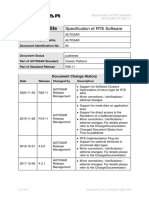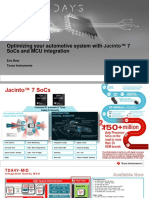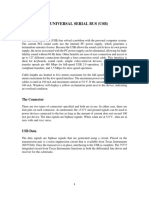CAN Protocol Specification: CAN 2.0 Part A (PDF) CAN 2.0 Part B PDF
Uploaded by
Vinod ViniCAN Protocol Specification: CAN 2.0 Part A (PDF) CAN 2.0 Part B PDF
Uploaded by
Vinod ViniCAN protocol specification
CAN Specification 2.0 describes the base frame format (using 11-bit CAN-identifier) and the extended frame format (using 29-bit CAN-identifier). In order to distinguish base and extended frame format the identifier extension (IDE) bit in the control field of the CAN message, as it is defined in CAN Specification 2.0 Part A, is used. This is done in such a way that the frame format in CAN Specification 2.0 Part A is equivalent to the base frame format and therefore is still valid. Furthermore, the extended frame format has been defined so that messages in base format and extended format can coexist within the same network. The extended frame format has some trade-offs: The bus latency time is longer (in minimum 20 bit-times), messages in extended format require more bandwidth (about 20%), and the error detection performance is lower (because the 15-bit CRC is optimized for frame length of about 80 bit). This CAN Specification 2.0 consists of two parts, with
CAN 2.0 Part A (pdf) describing the CAN base frame format; CAN 2.0 Part B (pdf) describing both base and extended frame formats. In order to be compatible with the CAN Specification 2.0 it is required that a CAN implementation is compatible with either Part A or Part B. CAN 2.0 Addendum (pdf)
Implementation guide for the CAN protocol
The Controller Area Network protocol specification document describes the function of the network on the whole. Additionally, Bosch provides a Reference CAN Model to the CAN licensees, supporting the protocols implementation into the licensees CAN controller nodes. NOTE: The official CAN specification has been released by ISO as 11898-1 (CAN data link layer protocol). There are two CAN physical layers standardized by ISO (11898-2: CAN highspeed transmission; and ISO 11898-3: CAN fault-tolerant transmission).
You might also like
- Winidea Build 9.17.172.0.109652 Test Report: Renesas Rh850No ratings yetWinidea Build 9.17.172.0.109652 Test Report: Renesas Rh8502 pages
- Probability and Stochastic Processes A F PDF100% (1)Probability and Stochastic Processes A F PDF787 pages
- 100 English Sentences Used in Daily Life - English Grammar HereNo ratings yet100 English Sentences Used in Daily Life - English Grammar Here8 pages
- Advanced PIC18 Projects-CAN Bus ProjectsNo ratings yetAdvanced PIC18 Projects-CAN Bus Projects40 pages
- An Overview of Controller Area Network (CAN) Technology: November 12, 2003No ratings yetAn Overview of Controller Area Network (CAN) Technology: November 12, 200320 pages
- Vector CANoe and CANalyzer Are Two Powerful Software Tools For The DevelopmentNo ratings yetVector CANoe and CANalyzer Are Two Powerful Software Tools For The Development1 page
- CANalyzer Workshops Overview FactSheet enNo ratings yetCANalyzer Workshops Overview FactSheet en2 pages
- Open Source Vehicle ECU Diagnostics and Testing Platform: University of Reading Department of Computer ScienceNo ratings yetOpen Source Vehicle ECU Diagnostics and Testing Platform: University of Reading Department of Computer Science113 pages
- A Modular System Architecture For Sensor Data Processing of ADAS Applications100% (1)A Modular System Architecture For Sensor Data Processing of ADAS Applications6 pages
- Real-Time Operating Systems (RTOS) BasicsNo ratings yetReal-Time Operating Systems (RTOS) Basics8 pages
- Embedded System Development Coding Reference Guide100% (1)Embedded System Development Coding Reference Guide190 pages
- Introduction To Popcornsar Adaptive Autosar (R20-11) Tool ChainNo ratings yetIntroduction To Popcornsar Adaptive Autosar (R20-11) Tool Chain27 pages
- Arduino MCP2515 CAN Bus Interface Tutorial - CAN ProtocolNo ratings yetArduino MCP2515 CAN Bus Interface Tutorial - CAN Protocol1 page
- VeCo12 3 Diagnostics 1 Geffers Lecture PDF100% (1)VeCo12 3 Diagnostics 1 Geffers Lecture PDF24 pages
- Mcu-Link: Mcu-Link Debug Probe: High Performance, Low-Cost Debug Tool For Arm Cortex M Based McusNo ratings yetMcu-Link: Mcu-Link Debug Probe: High Performance, Low-Cost Debug Tool For Arm Cortex M Based Mcus6 pages
- Optimizing Your Automotive System With Jacinto™ 7 Socs and Mcu IntegrationNo ratings yetOptimizing Your Automotive System With Jacinto™ 7 Socs and Mcu Integration18 pages
- Electronic Control Units (Ecus) : Part 1: in - Car NetworkingNo ratings yetElectronic Control Units (Ecus) : Part 1: in - Car Networking27 pages
- 802.1BA-2011 - IEEE STD For LAN&MANs - Audio Video Bridging (AVB) SystemsNo ratings yet802.1BA-2011 - IEEE STD For LAN&MANs - Audio Video Bridging (AVB) Systems45 pages
- Lin Bus Based Data Acquisition and Control System Using PsocNo ratings yetLin Bus Based Data Acquisition and Control System Using Psoc47 pages
- Introduction To AVR Microcontrollers: College of EngineeringNo ratings yetIntroduction To AVR Microcontrollers: College of Engineering33 pages
- An-InD-1-004 Diagnostics Via Gateway in CANoeNo ratings yetAn-InD-1-004 Diagnostics Via Gateway in CANoe15 pages
- Renesas Flash Programmer Package V20401 FreeNo ratings yetRenesas Flash Programmer Package V20401 Free19 pages
- 3.5 Can Protocol: Floor, Eureka Court, Beside Image Hospital, Ameerpet, HYDERABAD 73No ratings yet3.5 Can Protocol: Floor, Eureka Court, Beside Image Hospital, Ameerpet, HYDERABAD 7319 pages
- Methodology of AUTOSAR and Communication in AUTOSAR-1-1 PDFNo ratings yetMethodology of AUTOSAR and Communication in AUTOSAR-1-1 PDF49 pages
- Instant Access to Critical Thinking in Clinical Practice Improving the Quality of Judgments and Decisions Second Edition Eileen Gambrill ebook Full Chapters100% (1)Instant Access to Critical Thinking in Clinical Practice Improving the Quality of Judgments and Decisions Second Edition Eileen Gambrill ebook Full Chapters81 pages
- Paper-5 Analysis of Integrating External Trustworthiness Software & Study On Information Retrieval SystemsNo ratings yetPaper-5 Analysis of Integrating External Trustworthiness Software & Study On Information Retrieval Systems8 pages
- Mga Kontemporaryong Isyu: Yunit I Week 1-3No ratings yetMga Kontemporaryong Isyu: Yunit I Week 1-36 pages
- 7.1 Coyne2019 - Ludwig Von Mises On War and The EconomyNo ratings yet7.1 Coyne2019 - Ludwig Von Mises On War and The Economy14 pages
- Civil Procedure Code and Limitation Law Final Draft - Srijita Kundan, Roll No. 133No ratings yetCivil Procedure Code and Limitation Law Final Draft - Srijita Kundan, Roll No. 13316 pages
- Hull OFOD10e MultipleChoice Questions Only Ch22No ratings yetHull OFOD10e MultipleChoice Questions Only Ch224 pages
- Section #2: © 2019 ZS Associates - CONFIDENTIAL Section2 - Solution Presentation TemplateNo ratings yetSection #2: © 2019 ZS Associates - CONFIDENTIAL Section2 - Solution Presentation Template11 pages
- IBA International Principles On Conduct For The Legal Profession May 2011No ratings yetIBA International Principles On Conduct For The Legal Profession May 201136 pages

























































































